The second coming of Jim McGuinness has brought great interest into Donegal and exactly what it is they are trying to do. We are still in the very early stages, so it is hard to know what the end creation is going to be, but we have got an insight so far into what he is bringing in terms of structure, both in and out of possession. Their game against Derry was always going to throw up something very specific as McGuinness has always made it his business to dethrone the existing kings of Ulster and obsesses on how to beat the best.
Defensive Structure
Donegal have operated an extremely deep compact defence in their two championship games to date. There is no surprise in this, as this was the foundation on which McGuinness’s first coming in Donegal was built. The difference this time is there is no immediate out balls, compared with two left up top a decade ago. Donegal have everyone back in a compact shape, which shifts right and left in line with the opposition attacking structure.
Sean Patton/Gavin Mulreany have yet to concede a goal across the two games, with even half chances not appearing. This defensive shape resulted in Derry shooting at 50 per cent, 0-17 from 34 efforts at the posts. Some of this was down to impatience from Derry in their attacking structure, something unusual for them. While Tyrone over the course of the 80-minute contest only managed 28 shots at the posts, faring a little better with a 57 per cent conversion rate, still well below a figure expected to win at this level.
Every player is expected to move in unison to shut down the opposition attack but there is one outlier to this: their go-to man marker Brendan McCole.
READ MORE
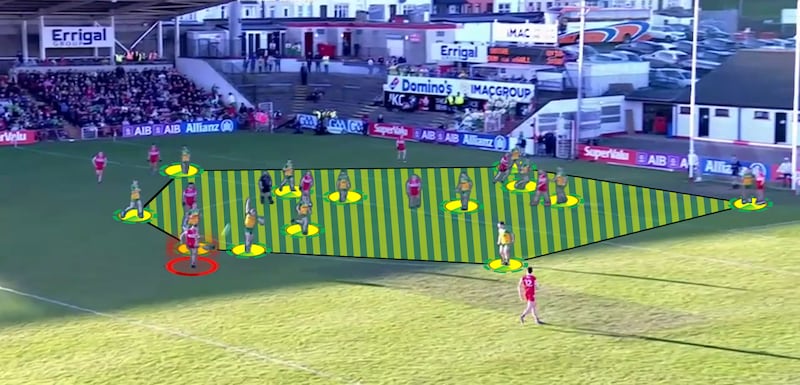
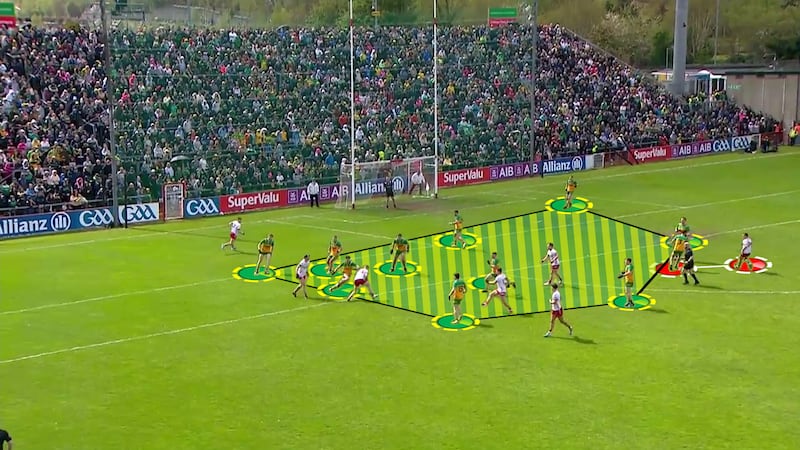
Brendan McCole’s man marking
McCole has given two immense man-marking performances against Shane McGuigan and Darragh Canavan in the opening two rounds of Ulster. In the Ulster quarter-final, he restricted the Derryman mostly to stagnant possession outside the danger zone – and a shot at the posts that went wide –,and the Sigerson Cup-winning captain with DCU Dóchas Éireann had a huge turnover on a 60:40 ball inside during the opening half.
Such was the discipline of the collective Donegal defence that McGuigan only had two frees at the post during the entire contest and he only registered his two points in second-half injury time, when the result was no longer in doubt and the concession of points was acceptable rather than three pointers. McCole simply didn’t give McGuigan room to breath in the areas in which he had been so impactful in last year’s Championship and this year’s league.
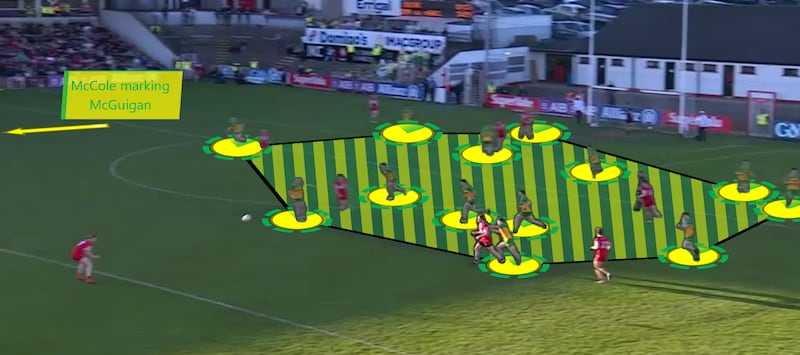
McCole’s tenacity was evident again against Tyrone, as he was tasked with marking Canavan. Canavan typically flourishes in open spaces and it was only on long Morgan kick-outs where these spaces briefly existed before the Donegal cavalry clogged up areas. It was two direct balls into defence from long Morgan kick-outs, where he won a free after a foul by goalkeeper Mulreany and won a mark, that led to two scores. Canavan also got two great points from play in either half, one from a sloppy Donegal middle-third turnover. Space was at a premium and he was limited to 11 possessions in the entire game, while he didn’t touch the ball across the entirety of extra time. McCole made a match-winning interception as Niall Morgan looked to slip Canavan in on the 20m line. McCole’s influence wasn’t limited to his steely shutdown of the two marquee Ulster forwards, he also converted the equalising score in normal time to force extra time.
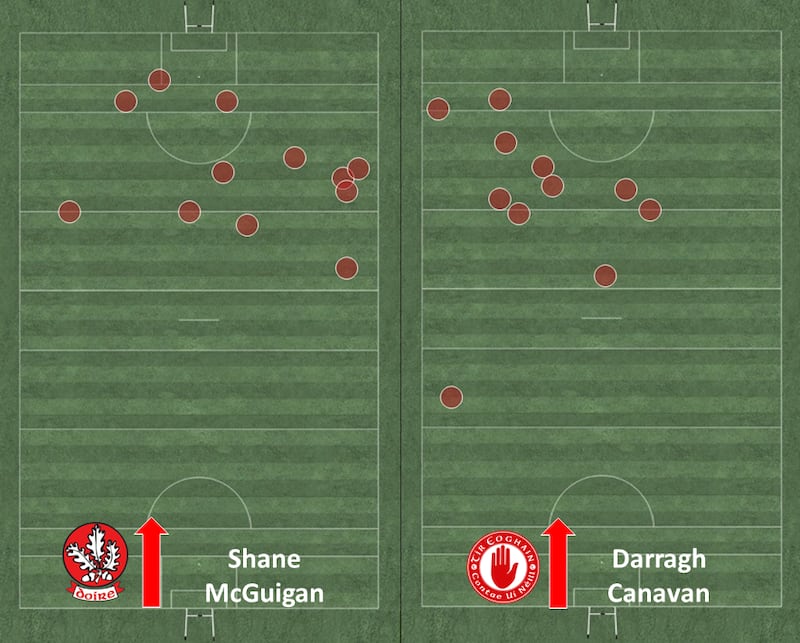
Donegal kick-outs
Donegal scored heavily off their long kick-outs against Derry but the narrative of Odhran Lynch being the fall guy is simplistic. Conor Glass was not the man under any of the three long kick-outs that resulted in goals, as Donegal removed him from the contest. It was co-ordinated savagery around the breaks that allowed Donegal get behind the Derry defensive line with ease. The strange thing was, this wasn’t a surprise, this approach was used as early as the opening three games in the league, with the third goal against Derry a replica of Donegal’s late goal against Cork in the league with a wave of Donegal men bearing down on goal.

Tyrone used a completely different approach, as they gave up the kick-outs of Mulreany completely. This was and wasn’t a surprise, as of course Tyrone were going to be spooked by the 3-3 that Donegal scored off their long kick-outs versus Derry, and Tyrone also used the same approach of giving up the kick-out against Cavan. The absence of Patton did potentially dampen this threat a little, but Tyrone never looked to mix it up and get Donegal thinking. The question is: did this work any better for Tyrone? It may not have had the same punch-in-your-face effect, but Donegal still scored 0-10 from their 20 short kick-outs, turning half of these free possessions into scores.
Length of possession
The manner in which Derry and Tyrone set up defensively had an impact on how Donegal attacked. It appears that Donegal want to be a swashbuckling risk-taking counter-attacking team, but they can also play it slow and methodically. This all-out attack with runners in waves and looking to take men on in one-on-one battles was the most evident part of the Derry game, as they scored off their own long kick-outs and fast turnovers furiously.
They scored 4-3 in possessions lasting under 20 seconds, and while this is obviously helped by the long kick-outs and the defensive openness of Derry, they tended to struggle to convert possessions to scores once Derry retreated into their defensive structure. Tyrone were much more cautious in their approach, and this had a direct impact on how Donegal punched holes in their defence. Donegal only managed 0-1 from fast-paced attacks but they showed an additional string to their bow as they controlled multiphase possession, scoring 0-12 in attacks lasting more than 40 seconds.
This deliberate attacking patience was nowhere more clearly evident then the final score of normal time as they maintained possession for just over three minutes before McCole split the posts to send the game to extra time. A key part of these possessions is awareness of what you are doing when you don’t have the ball.,It seems that many of the Donegal players are clued into their role in clearing paths for the likes of Ryan McHugh, Shane O’Donnell, Daire Ó Baoill and Caolan McGonagle to attack opposition players one on one. It is also the case that Donegal are looking to create these one-on-one mismatches with opposition forwards, similar to the late free conceded by Cathal McShane.
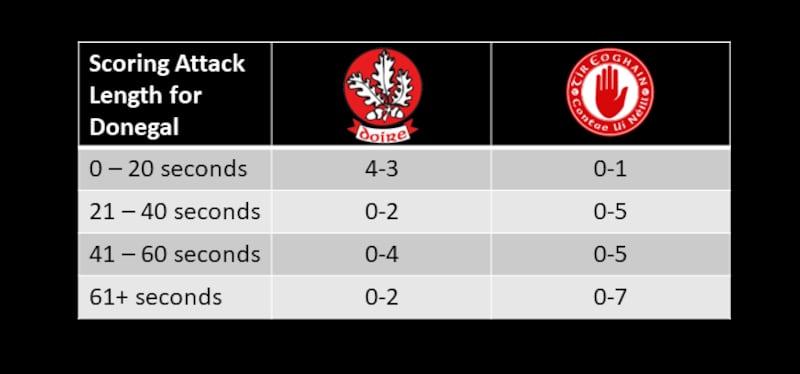
Ulster final
The Ulster final is likely to require a mixture of approaches from Donegal, as Armagh are able to switch things up in their game approach. The Division Two league final between the two sides is probably not a great barometer of what to expect, as Donegal were without McCole, Ryan McHugh and Paddy McBrearty, while on the Armagh side Rian O’Neill only made a late introduction. The thing about that final is the two teams were extremely cagey for the opening three quarters before a frantic closing quarter saw Donegal emerge winners by a single point. An intriguing Ulster final is certainly in store.
Paul O’Brien is a performance analyst with The Performance Process (twitter.com/NoPlanBGAA).















